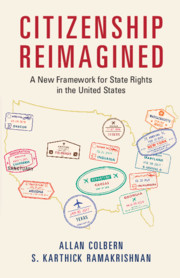Book contents
- Citizenship Reimagined
- Citizenship Reimagined
- Copyright page
- Dedication
- Contents
- Figures
- Tables
- Acknowledgments
- 1 Introduction
- 2 Citizenship in a Federated Framework
- 3 National and State Citizenship in the American Context
- 4 State Citizenship for Blacks
- 5 Worst to First
- 6 State Citizenship and Immigration Federalism
- 7 Enabling Progress on State Citizenship
- Book part
- Notes
- Select References
- Index
2 - Citizenship in a Federated Framework
Published online by Cambridge University Press: 30 October 2020
- Citizenship Reimagined
- Citizenship Reimagined
- Copyright page
- Dedication
- Contents
- Figures
- Tables
- Acknowledgments
- 1 Introduction
- 2 Citizenship in a Federated Framework
- 3 National and State Citizenship in the American Context
- 4 State Citizenship for Blacks
- 5 Worst to First
- 6 State Citizenship and Immigration Federalism
- 7 Enabling Progress on State Citizenship
- Book part
- Notes
- Select References
- Index
Summary
outlines the history of citizenship as a political concept, showing that the dominant view of citizenship today is still primarily seen as nationally provided and tied inextricably to legal status, despite global and urban scholars challenging its claims of exclusivity and immigration scholars challenging its singular focus on legal status. The limited power of these critiques is due, in part, to the fuzziness of claims regarding rights and identities. The authors make a fresh start in the systematic conceptualization of citizenship, showing that legal status is not the gateway to rights as is often assumed. In its place, they develop a concept of federated citizenship as a parallel set of rights along five key dimensions, with the provision of those rights varying by jurisdiction – federal, state, and local. They also lay out important differences between progressive citizenship, regressive citizenship, and reinforcing citizenship. Finally, they move from concept formation to the development of indicators for state citizenship regimes, which sets the stage for the empirical analysis is subsequent chapters on Black citizenship rights and immigrant citizenship rights.
Keywords
- Type
- Chapter
- Information
- Citizenship ReimaginedA New Framework for State Rights in the United States, pp. 19 - 70Publisher: Cambridge University PressPrint publication year: 2020

